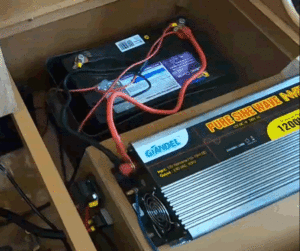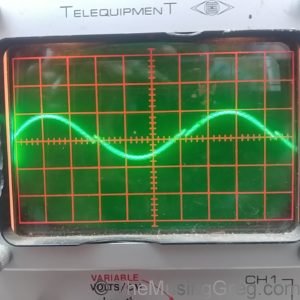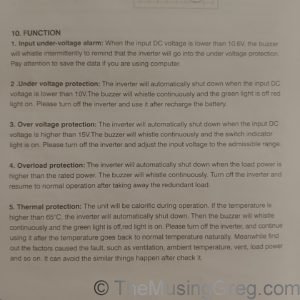I recently purchased a Giandel 1200W Pure Sine Wave Inverter for our caravan, and spent extended time testing it under a variety of load conditions.

At A Glance
Overall rating: ![]()
Price: $AU130
Customer Service: n/a
Product Quality: ![]()
Product link: Purchase on eBay
What I liked
- Affordable price – $130
- Fairly clean sinewave
- Waveform remains clean under load
- Fan only runs when needed
- Lightweight
- Includes mounting cut-outs for screws
What I didn’t
- Waveform not perfectly clean
- One mounting point directly below battery terminals, making access difficult
- 1A no-load current slightly high
Intro
The Giandel 1200W Pure Sine Wave Inverter is rated at 1200W with a peak load of 2400W. It’s designed to deliver a pure sine wave output from, in this case, a 12V DC input, so it’s good for cars, caravans, motor homes, RV’s, 5th wheelers etc. I bought the product from eBay from $130 in December 2019.
In the box
Inside the box you get:
- The inverter
- 2x DC power cables
- 1x remote start button
- Instruction manual
Installation and Use
 It’s pretty simple to wire up. Simply connect the red cable between your +12V supply positive terminal and the red terminal on the inverter, and the black cable between the black terminal on your battery and the black terminal on the inverter. You also need to connect a wire from the earth terminal on the inverter to a good earth, in my case, on the caravan.
It’s pretty simple to wire up. Simply connect the red cable between your +12V supply positive terminal and the red terminal on the inverter, and the black cable between the black terminal on your battery and the black terminal on the inverter. You also need to connect a wire from the earth terminal on the inverter to a good earth, in my case, on the caravan.
From there it’s a simple matter to switch it on with the power button and add your load.
Testing and Results
I tested the following loads:
- 80W LG mobile phone charger
- 120W Asus laptop charger
- 0-1800W Sunbeam hair dryer
- 1200W Black & Decker heat gun
- 0-2000W Makita heat gun (pulse-width modulated, meaning it sends pulses of 240V to the heating element and varies the width of those pulses to increase the average power draw and increase the heat output)
- 1200W microwave
In each case I had the inverter running before I turned the load on. Throughout the tests I monitored the shape of the waveform to confirm whether or not it was a pure sinewave or not, and also at various times monitored either the input current, the battery voltage or the inverter output voltage.
| Test | Result |
| Standby current draw – inverter turned off | 6 µA (0.006mA) |
| Standby current draw – inverter running with no load | 1.05A |
| 80W phone charger | Pass – clean waveform, power delivered |
| 120W laptop charger | Pass – clean waveform, power delivered |
| 0-1800W hair dryer | Marginal Pass – ran fine on cool setting but inverter turned off when heating |
| 1200W heat gun | Pass – clean waveform, power delivered |
| 0-2000W heat gun (PWM) | Marginal Pass – ran up to setting 2 out of 5 before inverter turned off. I feel it should have gone a bit further than this. |
| 1200W microwave | Fail – inverter turned off after about 2 seconds |
 The key great result was that the waveform remained clean throughout the test. It wasn’t a perfect sine wave – you can see some cross-over distortion where the positive half of the waveform stopped and the negative half started. Presumably this is where the positive transistors turn off and the negative ones start; but this is still probably cleaner than a normal mains supply and it seemed to improve as the tests progressed.
The key great result was that the waveform remained clean throughout the test. It wasn’t a perfect sine wave – you can see some cross-over distortion where the positive half of the waveform stopped and the negative half started. Presumably this is where the positive transistors turn off and the negative ones start; but this is still probably cleaner than a normal mains supply and it seemed to improve as the tests progressed.
The Makita heat gun test was very challenging for the inverter as the pulse-width modulated output meant the load was changing multiple times per second. However this never interfered with the quality of the waveform.
Another thing I liked about the inverter was that while the fan was a little noisy, it only ran when the load increased. So most of the time it was off, and thus very quiet.
 One criticism I have is that on the occasions the inverter shut down, it wasn’t clear if this was because the input voltage dropped too low or the output load was too high. On the microwave test I confirmed the input voltage only dropped to 11.6V before the inverter shut down and the input voltage is supposed to be able to drop to 10V before it shuts down. There was a long beep and the green operating light changed to red, but it wasn’t clear whether this meant undervoltage, overload or something else.
One criticism I have is that on the occasions the inverter shut down, it wasn’t clear if this was because the input voltage dropped too low or the output load was too high. On the microwave test I confirmed the input voltage only dropped to 11.6V before the inverter shut down and the input voltage is supposed to be able to drop to 10V before it shuts down. There was a long beep and the green operating light changed to red, but it wasn’t clear whether this meant undervoltage, overload or something else.
Another minor quibble is the 1A standby current – a little high I feel; and also that one of the mounting cut-outs is right under the negative battery terminal so it’s very hard to access with a screwdriver.
Conclusion
The Giandel 1200W pure sine wave inverter is a recommended product. It’s great value, lightweight and was able to hold a clean waveform. I feel its power rating may be slightly more than what it can supply – it was able to power the 1200W heat gun but not the 1200W microwave or the 0-2000W heat gun when only on setting 2 out of 5. So if it can supply 1200W at all, that seems to be the absolute limit with no margin of error, so consider a 1500W inverter if you’re expecting this to run a 1200W device.
However it otherwise performed very well and is a great choice for camping or travelling.
the 600w pure sine wave inverter can’t handle a laptop computer on charge.. I had one that died so they sent me another one and it died within 12 hours.. Apparently a transistor overheats when low loads like a laptop on charge are used. They the supplier would NOT honour the warranty they offered.
Wow that doesn’t sound good at all! 🙁 I had no problems myself with low loads on the 1200W unit, sorry to hear about the 600W unit though.